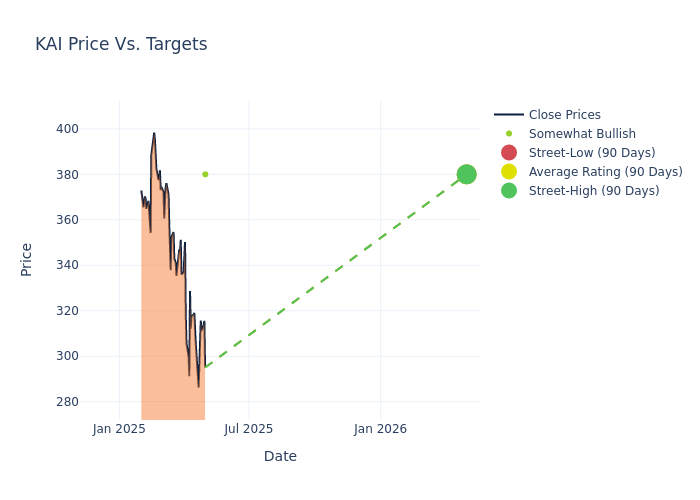Kadant Stock: A Deep Dive Into Analyst Perspectives (5 Ratings)
Providing a diverse range of perspectives from bullish to bearish, 5 analysts have published ratings on Kadant (NYSE:KAI) in the last three months.
The table below offers a condensed view of their recent ratings, showcasing the changing sentiments over the past 30 days and comparing them to the preceding months.
| Bullish | Somewhat Bullish | Indifferent | Somewhat Bearish | Bearish | |
|---|---|---|---|---|---|
| Total Ratings | 0 | 5 | 0 | 0 | 0 |
| Last 30D | 0 | 1 | 0 | 0 | 0 |
| 1M Ago | 0 | 2 | 0 | 0 | 0 |
| 2M Ago | 0 | 0 | 0 | 0 | 0 |
| 3M Ago | 0 | 2 | 0 | 0 | 0 |
Analysts' evaluations of 12-month price targets offer additional insights, showcasing an average target of $398.0, with a high estimate of $410.00 and a low estimate of $380.00. This current average represents a 1.49% decrease from the previous average price target of $404.00.

Investigating Analyst Ratings: An Elaborate Study
In examining recent analyst actions, we gain insights into how financial experts perceive Kadant. The following summary outlines key analysts, their recent evaluations, and adjustments to ratings and price targets.
| Analyst | Analyst Firm | Action Taken | Rating | Current Price Target | Prior Price Target |
|---|---|---|---|---|---|
| Gary Prestopino | Barrington Research | Maintains | Outperform | $380.00 | $380.00 |
| Gary Prestopino | Barrington Research | Lowers | Outperform | $380.00 | $410.00 |
| Gary Prestopino | Barrington Research | Maintains | Outperform | $410.00 | $410.00 |
| Gary Prestopino | Barrington Research | Maintains | Outperform | $410.00 | $410.00 |
| Gary Prestopino | Barrington Research | Maintains | Outperform | $410.00 | $410.00 |
Key Insights:
- Action Taken: In response to dynamic market conditions and company performance, analysts update their recommendations. Whether they 'Maintain', 'Raise', or 'Lower' their stance, it signifies their reaction to recent developments related to Kadant. This insight gives a snapshot of analysts' perspectives on the current state of the company.
- Rating: Unveiling insights, analysts deliver qualitative insights into stock performance, from 'Outperform' to 'Underperform'. These ratings convey expectations for the relative performance of Kadant compared to the broader market.
- Price Targets: Analysts navigate through adjustments in price targets, providing estimates for Kadant's future value. Comparing current and prior targets offers insights into analysts' evolving expectations.
Considering these analyst evaluations in conjunction with other financial indicators can offer a comprehensive understanding of Kadant's market position. Stay informed and make well-informed decisions with our Ratings Table.
Stay up to date on Kadant analyst ratings.
Discovering Kadant: A Closer Look
Kadant Inc. supplies process and engineering equipment for papermaking, recycling, lumber manufacturing, and related industries. The company's three reportable segments are the Flow Control segment which consists of the fluid-handling and doctoring, cleaning, & filtration product lines; the Industrial Processing segment which consists of the wood processing and stock-preparation product lines; and Material handling systems, which provides conveyor-belt equipment for industries such as mining, food processing, and packaging. The company has a geographic presence in the U.S., China, Asia, Germany, Canada, and Others.
Kadant: A Financial Overview
Market Capitalization Analysis: The company exhibits a lower market capitalization profile, positioning itself below industry averages. This suggests a smaller scale relative to peers.
Revenue Growth: Kadant displayed positive results in 3M. As of 31 December, 2024, the company achieved a solid revenue growth rate of approximately 8.11%. This indicates a notable increase in the company's top-line earnings. As compared to its peers, the company achieved a growth rate higher than the average among peers in Industrials sector.
Net Margin: The company's net margin is a standout performer, exceeding industry averages. With an impressive net margin of 9.31%, the company showcases strong profitability and effective cost control.
Return on Equity (ROE): Kadant's ROE stands out, surpassing industry averages. With an impressive ROE of 2.83%, the company demonstrates effective use of equity capital and strong financial performance.
Return on Assets (ROA): Kadant's ROA excels beyond industry benchmarks, reaching 1.65%. This signifies efficient management of assets and strong financial health.
Debt Management: Kadant's debt-to-equity ratio is below the industry average. With a ratio of 0.34, the company relies less on debt financing, maintaining a healthier balance between debt and equity, which can be viewed positively by investors.
Understanding the Relevance of Analyst Ratings
Within the domain of banking and financial systems, analysts specialize in reporting for specific stocks or defined sectors. Their work involves attending company conference calls and meetings, researching company financial statements, and communicating with insiders to publish "analyst ratings" for stocks. Analysts typically assess and rate each stock once per quarter.
In addition to their assessments, some analysts extend their insights by offering predictions for key metrics such as earnings, revenue, and growth estimates. This supplementary information provides further guidance for traders. It is crucial to recognize that, despite their specialization, analysts are human and can only provide forecasts based on their beliefs.
Which Stocks Are Analysts Recommending Now?
Benzinga Edge gives you instant access to all major analyst upgrades, downgrades, and price targets. Sort by accuracy, upside potential, and more. Click here to stay ahead of the market.
This article was generated by Benzinga's automated content engine and reviewed by an editor.